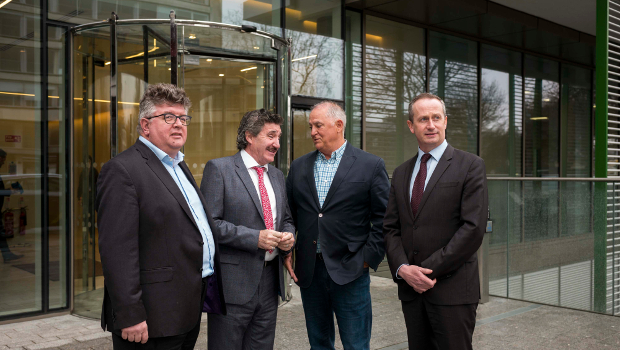Satellite communications company Viasat has announced an expansion of its Dublin office, as well as the establishment of a centre of excellence at its premises in Charlemont Place.
Stemming from the 2016 acquisition of Irish company Arconics, led by Niall O’Sullivan, Viasat now employs 100 people in Dublin, with the capacity to house 250, as it expands its operations in Europe.
“We are establishing Dublin as Viasat’s European Software Centre of Excellence, as part of our overall objective to strengthen our regional service capabilities as well as enhance collaboration with customers and partners throughout Europe,” said Rick Baldridge, president and chief operating officer, Viasat. “We believe the strong talent base located in Ireland will greatly expand our technical and business presence in the region, and enable us to rapidly respond to new global broadband opportunities across a number of industry sectors.”
Connected aircraft
Arconics had developed a connected aircraft software platform that included an application suite to communicate and share data with the aircraft and, using available connectivity, to connect with ground systems across mobile or avionics platforms.
As part of Viasat, O’Sullivan, now head of Viasat Ireland, said the Irish operation will continue to develop software products for customers, from the airline passenger, cabin managers, pilots and technicians, and beyond.
Viasat has ambitious plans to develop its satellite connectivity offerings, beyond what Balbridge terms a “fibre-like” experience. He said the company had already allowed US consumers to enjoy a satellite connectivity option that was more than a last resort when the likes of cable or DSL technologies were inadequate or unavailable.
High capacity satellites
In April 2016, Viasat launched the High Capacity Satellite (HCS) Applications Factory, in partnership with ESA to develop new products, applications and HCS-enabled services on an accelerated basis, with work performed in its UK and Switzerland offices.
Balbridge said the company was a pioneer in developing a “new class of satellite” known as High Throughput Satellites (HTS) to allow for greater bandwidth and capacity in satellite communications. This allows them to not only provide a service to users that is “fibre-like”, but that is also economically viable to compete with existing providers.
In November 2017, Viasat and the European Space Agency (ESA) announced Project AIDAN, a Public Private Partnership to develop key components for the ViaSat-3 satellite communications system with European industry. ViaSat-3 is expected to be able to deliver up to 400 times the capacity of current generations of satellites, in the 1 Terabit per second range.
O’Sullivan said a focus of the Irish operation will be to build a team and the products necessary to be able to handle and distribute that capacity to European customers.
Balbridge said that US customers can avail of services that offer 100MB/s connectivity services in area that are unserved by other services, or where it was not economically viable to offer them.
Service coverage
With distinct parallels for Ireland, these are not always rural areas, he said, but often customers are located in urban or extra-urban areas where services are patchy or poor in quality. Balbridge said that customers are often willing to pay more for quality services. Despite this, the per month cost in the US for 100Mb/s ranges from $50 to $75, depending on the package.
Balbridge expected the cost for services here to be in a similar range, when the infrastructure is in place.
Viasat already provides connectivity services in the airline industry, with Aer Lingus and Ryanair among its customers, but it also works with aircraft manufacturers and service providers to handle the masses of operational data produced in the aerospace industry.
Speaking at the announcement in Dublin, Minister of State at the Department of Business, Enterprise and Innovation and the Department of Education and Skills, John Halligan TD described the vibrant Irish space sector, with more than 60 Irish companies regularly working with the ESA. Minister Halligan said that for every euro invested in the space industry, the returns are around seven-fold.
Agency support
The Minister highlighted the importance of Science Foundation Ireland, and the development agencies, in facilitating Irish and international companies as they pursue work in the space sector here.
“I am pleased to see the prominent role the European Space Agency (ESA) and IDA Ireland can play in supporting the growth of companies, like Viasat, throughout Europe. Ireland is a region where companies can thrive through fostering ongoing research and innovation,” said the Minister.
“Ireland is recognised internationally as a leading location for companies in the software sector,” said Martin Shanahan, CEO, IDA Ireland. “Viasat’s decision to establish this European Software Centre of Excellence in Dublin is an endorsement of the talent pool and business environment here.”
Speaking at the announcement, Leo Clancy, head of technology, consumer and business services, IDA Ireland, said of software engineers and developers “We think that Ireland is a place that can attract the highest level of creative talent in the world.”
Clancy described Viasat’s decision to invest in Ireland as a “note of confidence in Ireland as an innovation centre”.
TechCentral Reporters







Subscribers 0
Fans 0
Followers 0
Followers